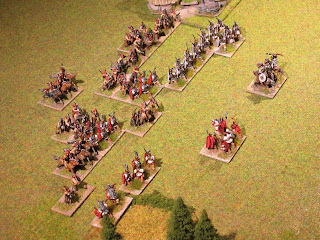Two new Roman armies, each led by a consul and totalling 80,000 troops marched to meet the barbarians near the Rhone River. The battle
that followed was a disaster (Arausio) for Rome with losses matching the defeat suffered
at Cannae, but like Hannibal, instead of pressing on Rome, the Cimbri and
Teutones moved elsewhere and crossed into Hispania.
The
Historical Match up.
The composition of the Roman army followed list number
II/33 (Polybian) and the Cimbri coalition (II/47a). In keeping with some semblance of historical
accuracy, a Roman army comprised of a citizen legion and an equal number of ‘allied’
troops forming a second legion; these can be seen carrying white shields. The troop
types follow the DBA army list to the letter, but are deployed in the game as
two separate groups.
Terrain, although arable, was kept to a minimum, one
BUA and two woods.
Game 1
Rome has deployed its force in two wings, the allied are on the
right and the Roman legion on the left nearest the wood. The Cimbri have
positioned three dense columns with smaller units of warriors filling in the
gaps and deployed thus, their army would match the Roman line in length.
As the battle commences, Rome moves forward as one massive group with skirmishers thrown forward on the wings. The Cimbri have moved two of their dense columns toward the Roman legion holding the third back as support.
The ensuing clashes Rome drives both dense columns
back, but somehow missed the barbarian breakthrough that now endangers their
exposed flank.
The situation becomes desperate as the supporting
Cimbri column charge the allied wing, Cimbri warriors assault the rear of the
Roman hastati and the Cimbrian chieftain delivers a personal message to the
Roman Consul.
The battle was in question as the allied legion had
collapsed the Cimbri left, but elsewhere, the Cimbri spurred on by their
general brought the decisive blow to the conflict. Score 4 – 3 for the Cimbri.
Game 2
The Roman force caught in the open deployed in their
standard formation, but held all the cavalry in a second line as a reserve. The
Cimbri, positioned between the village and wood arranged their troops in the
same manner as the previous battle.
The battle took an encouraging turn as the allied
legion repulsed every assault by the Cimbri. On the left, the Roman legion had
a harder time dealing with the two columns losing a unit of hastati for their
efforts.
On the Roman right, the allied wing now supported by
the cavalry were ready to roll up the Cimbrian left when the horns and drums signaled
a general retreat; resulting from the quick collapse of the Roman legion. Score
4 – 0 for the Cimbri.
Game 3
Rome deployed first but kept the citizen legion in the
centre with the allied troops split evenly and positioned on both flank. The
consul taking a centre position placed the allied cavalry on the left flank.
Although inconvenienced by the village and wood, the Cimbri kept to their
battle winning deployment but positioned their cavalry on the left flank.
Through mixed signals only the Cimbri left started the
battle and this was easily countered by the Roman right. Fearing an ambush, the
Roman centre moved cautiously forward.
The battle quickly escalated with the Roman right
heavily engaged with the warband and cavalry. The Roman centre was under
pressure by the dense columns sent against them, but they held their ground.
The drill and discipline of Rome was beginning to
whittle down Cimbrian resistance as they slowly caused more casualties than the
Cimbri could inflict. Score 4 – 1 for Rome.













No comments:
Post a Comment